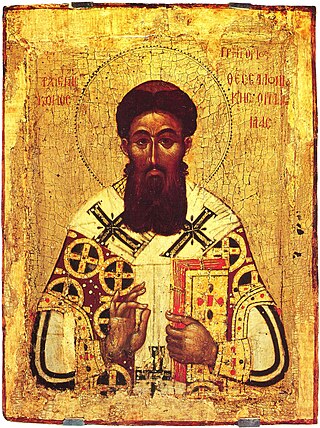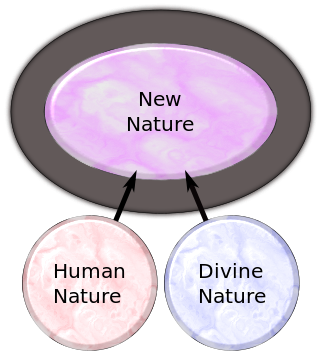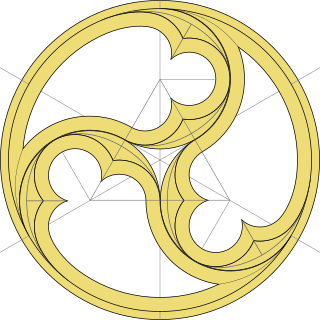
The Christian doctrine of the Trinity is the central doctrine concerning the nature of God in most Christian churches, which defines one God existing in three coequal, coeternal, consubstantial divine persons: God the Father, God the Son and God the Holy Spirit, three distinct persons (hypostases) sharing one essence/substance/nature (homoousion). As the Fourth Lateran Council declared, it is the Father who begets, the Son who is begotten, and the Holy Spirit who proceeds. In this context, one essence/nature defines what God is, while the three persons define who God is. This expresses at once their distinction and their indissoluble unity. Thus, the entire process of creation and grace is viewed as a single shared action of the three divine persons, in which each person manifests the attributes unique to them in the Trinity, thereby proving that everything comes "from the Father," "through the Son," and "in the Holy Spirit."

The Cappadocian Fathers, also traditionally known as the Three Cappadocians, are Basil the Great (330–379), who was bishop of Caesarea; Basil's younger brother Gregory of Nyssa, who was bishop of Nyssa; and a close friend, Gregory of Nazianzus (329–389), who became Patriarch of Constantinople. The Cappadocia region, in modern-day Turkey, was an early site of Christian activity, with several missions by Paul in this region.
Nontrinitarianism is a form of Christianity that rejects the mainstream Christian theology of the Trinity—the belief that God is three distinct hypostases or persons who are coeternal, coequal, and indivisibly united in one being, or essence. Certain religious groups that emerged during the Protestant Reformation have historically been known as antitrinitarian.

Jürgen Moltmann is a German Reformed theologian who is Professor Emeritus of Systematic Theology at the University of Tübingen and is known for his books such as the Theology of Hope, The Crucified God, God in Creation and other contributions to systematic theology. Jürgen Moltmann is the husband of Elisabeth Moltmann-Wendel, a notable feminist theologian. Jürgen Moltmann described his own theology as an extension of Karl Barth's theological works, especially the Church Dogmatics, and he has described his own work as Post-Barthian. He has received honorary doctorates from a number of institutions, such as Duke University (1973), the University of Louvain in Belgium (1995), the Alexandru Ioan Cuza University in Romania (1996), the Chung Yuan Christian University in Taiwan (2002), the Nicaraguan Evangelical University (2002), and the University of Pretoria in South Africa (2017). Moltmann was selected to deliver the prestigious Gifford Lectures in 1984–85, and was also the recipient of the 2000 University of Louisville and Louisville Presbyterian Theological Seminary Grawemeyer Award in Religion.

Miroslav Volf is a Croatian Protestant theologian and public intellectual and Henry B. Wright Professor of Theology and director of the Yale Center for Faith and Culture at Yale University. He previously taught at the Evangelical Theological Seminary in his native Osijek, Croatia and Fuller Theological Seminary in Pasadena, California (1990–1998).
Hypostatic union is a technical term in Christian theology employed in mainstream Christology to describe the union of Christ's humanity and divinity in one hypostasis, or individual personhood.

John Zizioulas was a Greek Orthodox bishop who served as the Metropolitan of Pergamon of the Ecumenical Patriarchate of Constantinople from 1986 until his death in 2023. He was one of the most influential Orthodox Christian theologians of the 20th and 21st centuries.

In Palamite theology, there is a distinction between the essence (ousia) and the energies (energeia) of God. It was formulated by Gregory Palamas (1296–1359) as part of his defense of the Athonite monastic practice of hesychasmos against the charge of heresy brought by the humanist scholar and theologian Barlaam of Calabria.

Eutychianism, also known as Real Monophysitism, refers to a set of Christian theological doctrines derived from the ideas of Eutyches of Constantinople. Eutychianism is a monophysite understanding of how the human and divine relate within the person of Jesus Christ, with Christ being in one nature and of two, with the humanity of Christ subsumed by the divinity.

Hypostasis, from the Greek ὑπόστασις (hypóstasis), is the underlying state or underlying substance and is the fundamental reality that supports all else. In Neoplatonism the hypostasis of the soul, the intellect (nous) and "the one" was addressed by Plotinus. In Christian theology, the Holy Trinity consists of three hypostases: Hypostasis of the Father, Hypostasis of the Son, and Hypostasis of the Holy Spirit.

Vladimir Nikolaievich Lossky was a Russian Eastern Orthodox theologian exiled in Paris. He emphasized theosis as the main principle of Eastern Orthodox Christianity.
Homoousion is a Christian theological term, most notably used in the Nicene Creed for describing Jesus as "same in being" or "same in essence" with God the Father. The same term was later also applied to the Holy Spirit in order to designate him as being "same in essence" with the Father and the Son. Those notions became cornerstones of theology in Nicene Christianity, and also represent one of the most important theological concepts within the Trinitarian doctrinal understanding of God.

Perichoresis is a term referring to the relationship of the three persons of the triune God to one another. Circumincession is a Latin-derived term for the same concept. It was first used as a term in Christian theology, by the Church Fathers. The noun first appears in the writings of Maximus Confessor but the related verb perichoreo is found earlier in Gregory of Nazianzus. Gregory used it to describe the relationship between the divine and human natures of Christ as did John of Damascus, who also extended it to the "interpenetration" of the three persons of the Trinity, and it became a technical term for the latter. It has been given recent currency by such contemporary writers as Jürgen Moltmann, Miroslav Volf, John Zizioulas, Richard Rohr, and others.
Prosopon is a theological term used in Christian theology as designation for the concept of a divine person. The term has a particular significance in Christian Triadology, and also in Christology.

Subordinationism is a Trinitarian doctrine wherein the Son is subordinate to the Father. Not only in submission and role, but with actual ontological subordination to varying degrees. It posits a hierarchical ranking of the persons of the Trinity, implying ontological subordination of the persons of the Son and the Holy Spirit. It was condemned as heretical in the Second Council of Constantinople.

Debate exists as to whether the earliest Church Fathers in Christian history believed in the doctrine of the Trinity – the Christian doctrine that God the Father, the Son and the Holy Spirit are three distinct persons sharing one homoousion (essence).
The following outline is provided as an overview of, and topical guide to, theology.
Christian theology is the study – theology – of Christian belief and practice. Such study concentrates primarily upon the texts of the Old Testament and of the New Testament, as well as on Christian tradition. Christian theologians use biblical exegesis, rational analysis and argument. Theologians may undertake the study of Christian theology for a variety of reasons, such as in order to:
Ousia is a philosophical and theological term, originally used in ancient Greek philosophy, then later in Christian theology. It was used by various ancient Greek philosophers, like Plato and Aristotle, as a primary designation for philosophical concepts of essence or substance. In contemporary philosophy, it is analogous to English concepts of being and ontic. In Christian theology, the concept of θεία ουσία is one of the most important doctrinal concepts, central to the development of trinitarian doctrine.
The position of the Eastern Orthodox Church regarding the Filioque controversy is defined by their interpretation of the Bible, and the teachings of the Church Fathers, creeds and definitions of the seven Ecumenical Councils, as well as the decisions of several particular councils of the Eastern Orthodox Church.